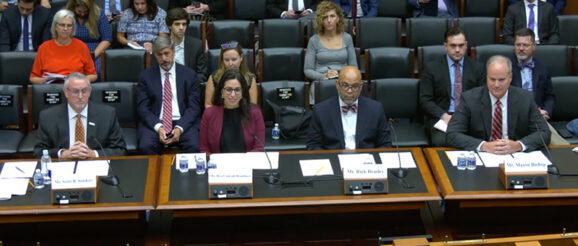More flexibility sought in WIOA for innovation

Flexibility was the word of the day at Wednesday’s House hearing on ways to revamp the nation’s main workforce development legislation.
The Workforce Innovation and Opportunity Act (WIOA), last reauthorized in 2014, doesn’t provide the needed flexibility for states and other stakeholders to keep up with quickly shifting workforce demands, according to witnesses at a hearing held by the House Education and the Workforce’s Subcommittee on Higher Education and Workforce Development. The speakers and several lawmakers contended that the legislation stymies innovation among states and other organizations, dissuades employers from participating because of unnecessary bureaucratic red tape, and doesn’t do enough to reach and encourage individuals to use the training services, among other criticisms.
“We are trying to operate in an iPhone economy with programs that were created and modeled from the New Deal and Great Society — and continue to do so,” said Mason Bishop, a nonresident fellow at the American Enterprise Institute (AEI) and former workforce development official at the U.S. Department of Labor. “We must modernize this program and provide the governance and service delivery improvements and flexibility that will allow innovation and new ideas.”
Big gaps
Vast worker shortages remain in key U.S. industries, noted Rya Conrad-Bradshaw, vice president of corporate markets at the education technology company Cengage Group. She pointed to the annual need of 300,000 certified allied health professionals and more than 663,000 open cybersecurity jobs, plus an estimated 2.1 million manufacturing jobs going unfilled by 2030.
Yet, there appears to be a disconnect in WIOA to serve those sectors, she said. In program year 2021, only 223,000 people received training services through WIOA’s adult, dislocated worker and youth formula grant programs, she added.
“This amounts to just 35% of those participating,” Conrad-Bradshaw said. “If we want WIOA to serve more learners, the program must refocus its mission to delivering the skills and competencies needed to fill the country’s most in-demand jobs.”
Some Democrats on the committee argued that it’s a matter of more funding and accountability.
“If we want to improve outcomes for job seekers, employers and taxpayers, we must put serious money behind the Workforce Innovation and Opportunity Act, while simultaneously holding training providers and workforce boards accountable,” said Rep. Frederica Wilson (D-Florida).
Republicans responded that won’t likely happen as lawmakers look to trim federal appropriations to meet spending caps as a federal government shutdown looms.
Look to Utah
The panelists and committee members discussed a few innovative workforce development models, especially ones that could benefit from more flexibility from federal rules and regulations.
AEI’s Bishop, who also has served in Utah’s workforce development program, noted that since the Covid pandemic, he has been contacted by several states about the well-regarded Utah model for workforce development. The problem is that WIOA prohibits states from implementing that innovative model, he said. One reason is that WIOA doesn’t allow states to test alternative approaches, said Bishop. Instead, states are creating their own workforce and economic development systems and funding mechanisms, he added.
Bishop recommended that Congress consider a similar approach to how welfare reform was handled in the 1990s. Some states were allowed to innovate using federal funds around welfare reform and social assistance programs, which eventually helped lead to bipartisan national reform in 1996, he said.
“I believe the same kind of bipartisan approach can occur in workforce development,” Bishop said.
Bishop, who is also a former Salt Lake Community College administrator, added that the systems frequently don’t work together, with higher education (particularly community colleges), workforce development boards and economic development boards all working on their own.
“One of the big weaknesses of the current system is it is not connected to community colleges in most communities,” he said, adding that WIOA rules create many of those walls from better coordination.
Better data
Several of the speakers also noted the need to provide more performance outcomes on the programs and to make the information more accessible and less confusing for potential program participants and employers. Conrad-Bradshaw cited a Harvard study that finds there are more than 7,000 eligible training providers encompassing about 75,000 eligible programs in more than 700 occupational fields nationwide.
“The sheer size and scope of these (eligible provider) lists make it hard for participants and employers to navigate to find the right program,” she said.
Further, most eligible programs do not provide any outcome data despite current law’s requirement to do so, Conrad-Bradshaw said. She said, based on the U.S. Department of Labor’s website TrainingProviderResults.gov — which is similar to the U.S. Education Department’s College Scorecard — more than 75% of programs lack basic program information on completion, employment rates, median earnings and credentials earned. She said this is due, in part, to the lack of consistent methods of collecting data, cost and difficulty in reporting the outcomes.
Scott on short-term Pell
Rep. Bobby Scott (D-Virginia), the ranking member on the full committee, brought up the issue of potentially providing Pell Grant access to quality short-term programs. Committee members have been mulling the so-called short-term Pell or Workforce Pell and appear to be trying to work through some areas of disagreement.
At Wednesday’s hearing, Scott seemed to lean toward the idea, asking if it could allow low-income individuals to access more federal assistance. He asked one witness, “If they had access to a Pell Grant, they’d be able to train a lot more people in your programs, is that right?”
Rick Beasley, executive director of the South Florida Workforce Investment Board, replied that if Pell covered the training costs, his organization would use the other resources for support services to help individuals complete their programs.
Rep. Virginia Foxx (R-North Carolina), chair of the full committee, immediately followed Scott in questioning, but she didn’t mention Workforce Pell, instead focusing her queries on better metrics and accountability.
